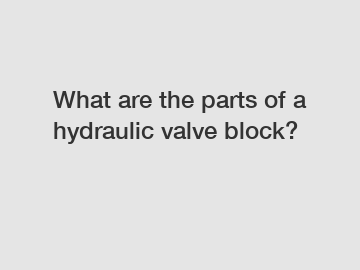What are the parts of a hydraulic valve block?
What Are the Parts of a Hydraulic Valve Block?
Hydraulic valve blocks play a crucial role in controlling the flow of fluid in hydraulic systems. They are commonly used in various industries such as manufacturing, construction, and aerospace. Understanding the different parts of a hydraulic valve block is essential for anyone working with hydraulic systems. In this article, we will explore the primary components of a hydraulic valve block and their functions.
1. Valve Cavity.

The valve cavity is the main body of the hydraulic valve block. It acts as a housing for the different valve components and provides a sealed environment for the fluid to flow through. It is typically made of high-quality materials such as steel or cast iron to withstand high pressures and ensure durability.
2. Ports.
Ports are openings in the valve block where fluid enters and exits. There are typically two types of ports: inlet and outlet ports. The inlet port allows fluid to enter the valve block from a hydraulic pump or reservoir, while the outlet port directs the flow of fluid to the desired actuator or circuit.
3. Spool.
The spool is a central component of the valve block responsible for controlling the flow of fluid. It is a cylindrical-shaped device that slides within the valve cavity, opening and closing different ports to regulate the direction and pressure of the fluid. The spool's position is often controlled by external factors such as pressure, temperature, or electrical signals.
4. Valve Springs.
Valve springs provide the necessary force to return the spool to its original position when external forces are not applied. They ensure that the valve remains in a neutral position when no pressure or electrical signals are present. Valve springs are crucial for maintaining the stability and integrity of the hydraulic system.
5. Actuating Device.
The actuating device is responsible for controlling the movement of the spool within the valve cavity. It can be in the form of a manual lever, solenoid, or pilot-operated mechanism. The actuating device receives signals from external sources and translates them into physical force, which then moves the spool and changes the flowpath of the fluid.
6. Seals and O-rings.
Seals and O-rings are essential components for maintaining the integrity of the hydraulic valve block. They create a tight seal between the different parts of the valve to prevent leakage and ensure efficient operation. Seals and O-rings are often made of synthetic rubber or polyurethane, which can withstand high pressures and temperature variations.
7. Pressure Relief Valve.
Many hydraulic valve blocks are equipped with a pressure relief valve. Its primary function is to protect the hydraulic system from overpressure. When the pressure exceeds a set limit, the pressure relief valve opens, allowing excess fluid to bypass and return to the reservoir. This prevents damage to the hydraulic system and helps maintain its overall stability.
In conclusion, a hydraulic valve block consists of several key components that work together to control the flow, pressure, and direction of fluid in hydraulic systems. Understanding these parts is crucial for maintaining and troubleshooting hydraulic systems effectively. If you have any questions or need assistance with hydraulic valve blocks, please do not hesitate to contact us.
Contact us to discuss your requirements of Two Way Flow Control Valve, Electromagnetic Ball Valve Price, wholesale Stacked hydraulic control check valve. Our experienced sales team can help you identify the options that best suit your needs.


